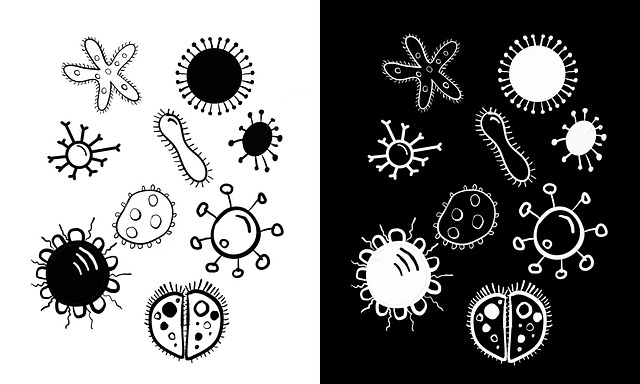The outcomes of infectious disease used to be assumed to follow the “one pathogen one disease model.” However, this model has been shown to be quite outdated. Increasingly, medical experts recognize the importance of polymicrobial infection for the infected individual. For example, COVID-19 patients with coinfections are more likely to develop severe disease and die. As many as one in five COVID-19 patients is estimated to have at least one coinfection. Risks and treatments for COVID-19, or any pathogen, cannot be understood without understanding coinfections.
What is coinfection?
Coinfection occurs when a person acquires two different pathogens simultaneously or when a chronically infected individual is re-infected with the same pathogen (known as superinfection) or is infected with a new pathogen.
Humans and other animals often encounter or have encountered more than one pathogen at the time of illness onset. Thus, pathogen encounters overlap and weave together over a lifetime. These pathogen encounters are part of the larger encounter and cohabitation we experience with the microbiome in the environment, in our skin, and inside our bodies. Rather than testing for and treating one pathogen at a time, as if each infection occurs in isolation, medical researchers are increasingly calling for a “pathobiome” approach to medicine with the greater appreciation for the prevalence and risks of polymicrobial infection.
Why is coinfection important?
When several pathogens are prevalent in a population, a person may be more likely to experience simultaneous or sequential infections. This is referred to as a “syndemic” (a network of health problems). A common example of syndemic infection is tuberculosis and HIV. When individuals in the same population are more likely to be exposed to multiple causative pathogens, some people in those populations become coinfected and develop both tuberculosis and AIDS. There are many examples of syndemic infections around the world, some of which may at first be unexpected, undiagnosed, and often result in higher rates of severe disease and death.

In the world of vector borne disease, vectors, like fleas and ticks, can transmit pathogenic cocktails. Multiple pathogens can be transmitted during a single exposure event or over time from sequential exposures. The risk of polymicrobial infection varies significantly by geography and by the types of fleas and ticks. In fact, vector biology and ecology are important predictors of the types of infections potentially transmitted in each region.
Polymicrobial infections or coinfections can have important consequences for the host (person or animal infected). One pathogen may alter the pathogenesis and disease progression after infection with a second pathogen. Certain pathogens can also impact the vector transmission potential of co-infecting pathogens that infect a person.
Researchers are also connecting that pathobiome to genetic associations with illness. This model of disease as “multifactorial” includes looking at genetics, the environment and the microbiome together. For example, researchers working on type 1 diabetes have identified genes associated with the condition, as well as a pathobiome, as well as triggering pathogens. Similar research has looked at the development of multiple sclerosis, Alzheimer’s disease, and long-term illness from tick-borne pathogens and COVID-19.
Find out more about multifactorial research and Alzheimer’s disease: could tick-borne pathogens play a role?
How do coinfections happen?
The most common way to get a coinfection is to encounter two different pathogens in the environment. These pathogens can occupy completely different infectious niches and may not commonly be associated with each other. For example, if a person happens to have a tick-transmitted Borrelia infection and is exposed to influenza, the illness would be considered a coinfection or concurrent infection with these two organisms.
Microbes routinely carried by a vector are called “symbionts.” Symbionts are organisms that occupy similar environments and often have close evolutionary relationships. Although many symbiotic relationships of bacteria within a vector are beneficial to the bacteria or tick or mutualistic to both, an example of symbiotic pathogens would be Borrelia burgdorferi and Anaplasma phagocytophilum, both of which can be transmitted by the same tick species.
Note that just because a person becomes infected with two or more tick-borne pathogens it does not always mean that they were all transmitted by the same tick. A person who is commonly exposed to ticks is in a population that may be more like the syndemic population, that is, in a situation where they can be exposed to more than one pathogen at more than one time point. Depending on a person’s lifestyle and where they are located, there are many opportunities to be exposed to ticks of different species, carrying different pathogens.
What other factors influence coinfections?
For a long time, the “one pathogen one disease” model dominated medical thinking. A transition to multifactorial research allows more holistic questions to be asked. What specific factors about the individual and the environment interacted with pathogens to lead to these disease symptoms? This question is being asked after a small study found that the presence of antibodies to Borrelia burgdorferi, the bacteria that causes Lyme disease, was correlated with more severe COVID-19.
What led to this correlation? It could be that exposure to B. burgdorferi changed the immune system in some way. It could also be that the host immune system already had a characteristic that changed how it responded to both B. burgdorferi and COVID-19. This multifactorial research is just beginning.
Research needed to better understand coinfections
The HIV epidemic taught us latent infections are much more common than previously recognized. Latent Bartonella henselae infections were famously discovered in HIV patients. We knew about cat scratch disease, but did not know the etiological agent, until the HIV epidemic resulted in a large population of immune-compromised individuals. One important take away here is that coinfection with a vector-borne pathogen is not restricted to only vector borne organisms, as illustrated by influenza (flu) in a person infected with HIV.
Doctors often talk about primary and secondary infection. Patients often ask which infection should be treated first? Right now, there are unclear answers for treatment prioritization for some tickborne agents. Unfortunately, the patient and doctor rarely know if a coinfection with Bartonella species and Borrelia species occurred at same time or if those with confirmed active infections with both pathogens experienced separate transmission events. Based on the emerging research and the historical findings from the HIV epidemic, it is possible that some immunocompetent, as well as immunocompromised, individuals carry Bartonella species infection for many months to years before developing serious illness. In fact, asymptomatic latent infection with Babesia, Bartonella, Borrelia, as well as many other pathogens is possible prior to developing a disease process that may or may not be associated with these vector-borne infections.
Suffice it to say, we have much to learn about coinfections. How do pathogens and non-pathogens interact in the pathogenesis of a disease in an individual patient? Could some diseases, such as SARS Long Hauler Syndrome be the sum product of coinfection or due to immune suppression induced by one or more organisms, thereby clearing the field for opportunistic pathogens to wreak havoc in a host? Could some pathogens work in concert to cause specific diseases like cancerous tumors or microcephaly? Pathobiome and microbiome researchers are working hard to answer these questions and more.
Further Reading
Coinfection. (2017). International encyclopedia of public health. Elsevier.
https://www-sciencedirect-com.ezproxy.babson.edu/topics/immunology-and-microbiology/coinfection
Vayssier-Taussat, M. et al. (2015). Emerging horizons for tick-borne pathogens: From the ‘one pathogen-one disease’ vision to the pathobiome paradigm. Future Microbiology, 10(12). https://doi.org/10.2217/fmb.15.114
https://www.futuremedicine.com/doi/abs/10.2217/fmb.15.114
Allotey, P., & Zhou, X-N. (Eds.) (2016). Co-infection and syndemics [Special Issue]. Infectious Diseases of Poverty, 5. https://www.biomedcentral.com/collections/CIS
Musuuza, J. S. et al. (2021, May 6). Prevalence and outcomes of co-infection and superinfection with SARS-CoV-2 and other pathogens: A systematic review and meta-analysis. PLOS One, 16(5), E0251170. https://doi.org/10.1371/journal.pone.0251170 https://journals.plos.org/plosone/article?id=10.1371/journal.pone.0251170
Yasunaga, J-I., & Matsuoka, M. (2017, November 15). Oncogenic spiral by infectious pathogens: Cooperation of multiple factors in cancer development. Cancer Science. https://doi.org/10.1111/cas.13443 https://onlinelibrary.wiley.com/doi/full/10.1111/cas.13443
Campos, M. C. et al. (2018, August 15). Zika might not be acting alone: Using an ecological study approach to investigate potential co-acting risk factors for an unusual pattern of microcephaly in Brazil. PLOS One, 13(8), e0201452. https://doi.org/10.1371/journal.pone.0201452 https://journals.plos.org/plosone/article?id=10.1371/journal.pone.0201452
Centers for Disease Control and Prevention. (2021, September 16). Post-COVID conditions. https://www.cdc.gov/coronavirus/2019-ncov/long-term-effects/index.html
Elhag, D. A. et al. (2021). Exploring the triple interaction between the host genome, the epigenome, and the gut microbiome in type 1 diabetes. International Journal of Molecular Sciences, 22(1), 125. https://doi.org/10.3390/ijms22010125 https://www.ncbi.nlm.nih.gov/pmc/articles/PMC7795494/
Szewczyk-Dąbrowska, A. et al. (2022). Correlation between COVID-19 severity and previous exposure of patients to Borrelia spp. Scientific Reports, 12, Article 15944. https://doi.org/10.1038/s41598-022-20202-x https://www.nature.com/articles/s41598-022-20202-x


